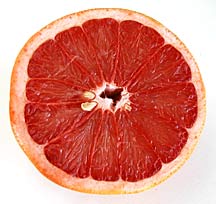|
Key Ingredient
|
Grapefruit
 |
The basics: The origin of grapefruit is a bit sketchy, but it is believed to be a natural hybrid of the pummelo and orange. The fruit was first identified in the mid-18th century in and around Jamaica and Barbados and was probably named because of the way it grew in grape-like clusters.
Grapefruit comes in three color varieties (white, pink and ruby red) and either seeded or seedless. All grapefruit are yellow-skinned, although the pink and ruby-red varieties can be marked by a tinge of pink. The red and pink varieties tend to be sweeter, but this time of year, all varieties should be very sweet and juicy.
Grapefruit is an excellent source of vitamin C
Selecting: Like all citrus, grapefruit should be heavy for its size. This is the sign of a juicy fruit. Look for smooth skin that is brightly colored and glossy. Avoid fruit with wrinkled skin or soft spots. Grapefruit is harvested ripe, so there is no need for further ripening.
Storing: Grapefruit should be placed in a plastic bag in the refrigerator and will keep for a couple of weeks.
Use: Grapefruit is a quintessential, refreshing breakfast item. It is commonly served halved so the segments can be scooped out. But with a little bit of effort, grapefruit can be segmented: Cut off the top and bottom skin portions, then cut away the peel from top to bottom, just until the flesh is revealed. Holding the fruit in hand, cut between the membranes and into segments. Don't forget to squeeze the remaining juice from the membranes.
Grapefruit can be enjoyed as is or mixed in fruit salads, tossed in green salads or made into citrus vinaigrettes or sauces. The fruit can also be juiced to make refreshing smoothies and drinks.
Where to buy: Grapefruit is easily found in supermarkets. Some local varieties can be found at the farmers' markets or Chinatown. Prices range from $1 to $2 per fruit, depending on size.
![]()
a free-lance food writer. Contact her
online through features@starbulletin.com
[News] [Business] [Features] [Sports] [Editorial] [Do It Electric!]
[Classified Ads] [Search] [Subscribe] [Info] [Letter to Editor]
[Feedback]
